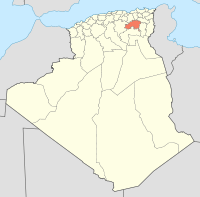Lambaesis
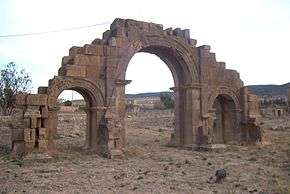 Arch of Septimius Severus. | |
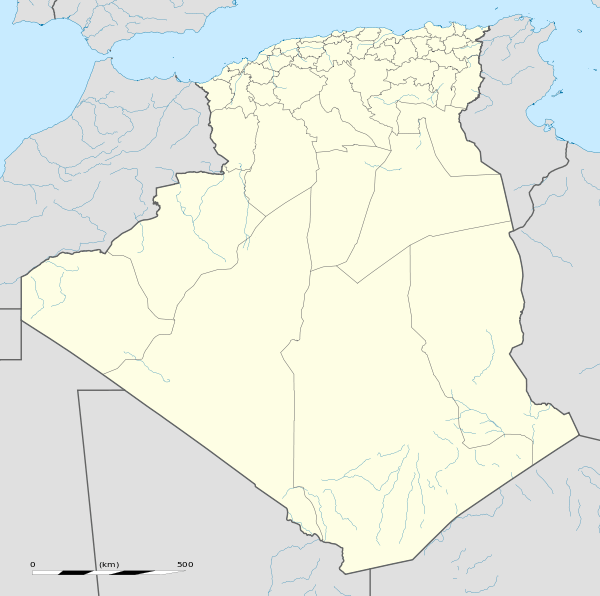 Shown within Algeria | |
| Alternate name | Lambaesa (Lambese) |
|---|---|
| Location | Tazoult, Batna Province, Algeria |
| Coordinates | 35°29′20″N 06°15′21″E / 35.48889°N 6.25583°ECoordinates: 35°29′20″N 06°15′21″E / 35.48889°N 6.25583°E |
| Type | Settlement |
| History | |
| Periods | Roman Empire |
| Site notes | |
| Condition | In ruins |
Lambaesis (Lambæsis), Lambaisis, or Lambaesa (Lambèse in colonial French), is a Roman ruin in Algeria, 7 miles (11 km) southeast of Batna and 17 miles (27 km) west of Timgad, located next to the modern village of Tazoult.[1] The former bishopric is also a Latin Catholic titular bishopric.
History
Lambaesa was founded by the Roman military. The camp of the third legion (Legio III Augusta), to which it owes its origin, appears to have been established between 123 and 129 AD, in the time of Roman emperor Hadrian, whose address to his soldiers was found inscribed on a pillar in a second camp to the west of the great camp still extant. However, other evidence suggests it was formed during the Punic Wars.
The town is built 622 m above sea level in the plain and on the spurs of the Djebel Asker[2]
By 166 AD mention is made of the decurions of a vicus, 10 curiae of which are known by name; and the vicus became a municipium probably at the time when it was made the capital of the newly founded province of Numidia. Lambaesis was populated mainly by Romanized Berbers and by some Roman colonists with their descendants: Latin was the official and commonly used language (even if local Berbers spoke their own language mixed with Latinisms).
III Augusta was disbanded by Gordian III and the legionaries dispersed among the North African provinces. But the legion was restored in the 250s by Valerianus and Gallienus and from then on the legion was known as Augusta Restituta. Its final departure did not take place till after 392 AD (the town soon afterwards declined).

Indeed, under Septimius Severus (193 AD), Numidia was separated from Africa Vetus, and governed by an imperial procurator. Under the new organization of the empire by Diocletian, Numidia was divided in two provinces: the north became Numidia Cirtensis, with capital at Cirta, while the south, which included the Aurès Mountains and was threatened by raids, became Numidia Militiana, "Military Numidia", with capital at the legionary base of Lambaesis. Subsequently however, Emperor Constantine the Great reunited the two provinces in a single one, administered from Cirta, which was now renamed Constantina (modern Constantine, Algeria) in his honour. Its governor was raised to the rank of consularis in 320 AD, and the province remained one of the seven provinces of the diocese of Africa until the invasion of the Vandals in 428 AD, which began its slow decay, accompanied by desertification. The province remained under Vandal rule, but was effectively limited to the coastal areas by Berber raids. It was restored to Roman rule after the Vandalic War, when it became part of the new praetorian prefecture of Africa.
The Byzantines occupied Lambaesis and vicinity from the sixth century but around 683 AD the Arabs conquered the area, naming what remained of the city Bar-el-Molouk in the 10th century.
Ecclesiastical history
Lambaesis was an episcopal see during late Ancient times as part of the Roman province of Numidia.[3] For such an important town its Bishopric is surprisingly absent from the historical record. Lambaesis did not send a representative to the Council of Nicaea[4] nor Chalcedon[5] and is not mentioned by LeQuinn .[6]
Saint Cyprian mentions a heretic bishop of Lambaesis who was condemned by a local synod of bishops around the year 240.[7][8]
Titular see
The extinct diocese was nominally restored as a titular bishopric. Initially revived as Lambaisis, it was renamed Lambaesis in 1925.
It has had the following incumbents, of the lowest (episcopal) rank :
- Jan Dembowski (1759.09.24 – 1790)
- Hieronim Stojnowski (Stroynowski) (1804.08.20 – 1814.09.26)
- Mateo José González Rubio (1836.02.01 – 1845.06.15)
- Eduardo Vásquez, Dominican Order (O.P.) (1853.12.30 – 1856.12.12)
- Thomas O’Callaghan, O.P. (1884.06.29 – 1886.12.03)
- Jean-Marie-Michel Blois (衛忠藩), Paris Foreign Missions Society (M.E.P.) (1921.12.29 – 1946.04.11), as Apostolic Vicar of Southern Manchuria 南滿 (China) (1921.12.19 – 1924.12.03) and as Apostolic Vicar of Shenyang 瀋陽 (China) (1924.12.03 – 1946.04.11), later promoted first Metropolitan Archbishop of Shenyang 瀋陽 (China) (1946.04.11 – 1946.05.18)
- James Moynagh, S.P.S. (1947.06.12 – 1950.04.18)
- Vincenzo Maria Jacono (1950.09.08 – 1955.02.02)
- Thomas Edward Gill (1956.04.11 – 1973.11.11)
- John Stephen Cummins (1974.02.26 – 1977.05.03)
- John Joseph Paul (1977.05.17 – 1983.10.14)
- Cardinal Marian Jaworski (1984.05.21 – 1991.01.16), while Apostolic Administrator of Lviv (Ukraine) (1984.05.21 – 1991.01.16), later Metropolitan Archbishop of the same Lviv (Ukraine) (1991.01.16 – 2008.10.21), President of Episcopal Conference of Ukraine (1994 – 2008.10.21), Apostolic Administrator of Lutsk (Ukraine) (1996 – 1998.03.25), Cardinal-Priest of S. Sisto (2001.02.21 [2001.05.20] – ...)
- Michel Pierre Marie Mouïsse (2000.03.10 – 2004.03.05)
- Carlo Roberto Maria Redaelli (2004.04.08 – 2012.06.28), (later Archbishop)
- David Prescott Talley (2013.01.03 – ...), Auxiliary Bishop of Atlanta (USA)
Remains
The remains of the Roman town, and more especially of the Roman camp, in spite of wanton vandalism, are among the most interesting ruins in northern Africa.
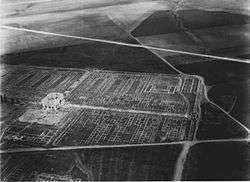
The ruins are situated on the lower terraces of the Aures Mountains, and consist of triumphal arches (one to Septimius Severus, another to Commodus), temples, aqueducts, vestiges of an amphitheatre, baths and an immense quantity of masonry belonging to private houses. To the north and east lie extensive cemeteries with the stones standing in their original alignments; to the west is a similar area, from which, however, the stones have been largely removed for building the modern village.
Of the temple of Aesculapius only one column is standing, though in the middle of the 19th century its façade was entire. The capitol or temple dedicated to Jupiter, Juno and Minerva, which has been cleared of debris, has a portico with eight columns. On level ground about two-thirds of a mile from the centre of the ancient town stands the camp, its site now partly occupied by the penitentiary and its gardens. It measures 1,640 feet (500 m) by 1,476 feet (450 m), and in the middle rise the ruins of a building commonly called, but incorrectly, the praetorium. This noble building, which dates from 268, is 92 feet (28 m) long by 66 feet (20 m) broad and 49 feet (15 m) high; its southern façade has a splendid peristyle half the height of the wall, consisting of a front row of massive Ionic columns and an engaged row of Corinthian pilasters.
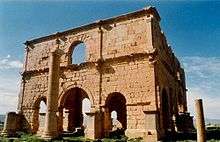
Behind this building (which was roofed), is a large court giving access to other buildings, one being the arsenal. In it have been found many thousands of projectiles. To the southeast are the remains of the baths. The ruins of both city and camp have yielded many inscriptions (Renier edited 1500, and there are 4185 in CIL viii); and, though a very large proportion are epitaphs of the barest kind, the more important pieces supply an outline of the history of the place. Over 2500 inscriptions relating to the camp have been deciphered. In a museum in the village are objects of antiquity discovered in the vicinity.[9] In addition to inscriptions and statues, there are some fine mosaics found in 1905 near the arch of Septimius Severus. The statues include those of Aesculapius and Hygieia, taken from the temple of Aesculapius.
About 2 miles (3.2 km) south of Lambessa are the ruins of Markuna, the ancient Verecunda, including two triumphal arches.
- Mosaic at Lambaesis
- Legions Barracks
- Arean at Lambèse
 Ruins at Tazoult
Ruins at Tazoult- Roman Bridge at Tazoult
- Roman Era Arch
 Arch of Spetimus Severus 1850s
Arch of Spetimus Severus 1850s
Notes
- ↑ René Cagnat. Lambèse. Lerous, Paris 1893 (Original in French)
- ↑ Lambaesis ( )
- ↑ Frend, W.H.C. (1984). The Rise of Christianity. Fortress Press. p. 313. ISBN 0-8006-1931-5.
- ↑ Heinrich Gelzer, Patrum Nicaenorum nomina Latine, Graece, Coptice, Syriace, Arabice, Armeniace. (In aedibus B.G. Teubneri, 1995 ).
- ↑ Richard Price, Michael Gaddis, The Acts of the Council of Chalcedon, Volume 1 (Liverpool University Press, 2005).
- ↑ Michel Lequien, Oriens christianus in quatuor Patriarchatus digestus', Paris 1740, Vol. I.
- ↑ Dictionnaire d’Archeologie Chretienne et de Liturgie, volume 8 columns 1067-1075
- ↑ Burns, J. Patout (2002). Cyprian the Bishop. London: Routledge. pp. 106–108. ISBN 0415238498.
- ↑ René Cagnat. Musée de Lambèse. Leroux, Paris 1895 (Original in French)
References
- S. Gsell, Les Monuments antiques de l'Algerie (Paris, 1901) and L'Algérie dans l'antiquité (Algiers, 1903);
- L. Renier, Inscriptions romaines de l'Algérie (Paris, 1855);
- Gustav Wilmann, "Die rm. Lagerstadt Afrikas", in Commentationes Phil. in honoreni Th. Mommseni (Berlin, 1877);
- Sir L. Playfair, Travels in the Footsteps of Bruce (London, 1877);
- A. Graham, Roman Africa (London, 1902).
![]() This article incorporates text from a publication now in the public domain: Chisholm, Hugh, ed. (1911). "article name needed". Encyclopædia Britannica (11th ed.). Cambridge University Press.
This article incorporates text from a publication now in the public domain: Chisholm, Hugh, ed. (1911). "article name needed". Encyclopædia Britannica (11th ed.). Cambridge University Press.
Source and External links
| Wikimedia Commons has media related to Lambese. |
- Joint Anglo-Algerian excavations of Lambaesis — archaeological team since 1985.
- GigaCatholic with titular incumbent biography links
- Archeorom3.site: Photos from Lambaesis
%2C_Algeria_04966r.jpg)
